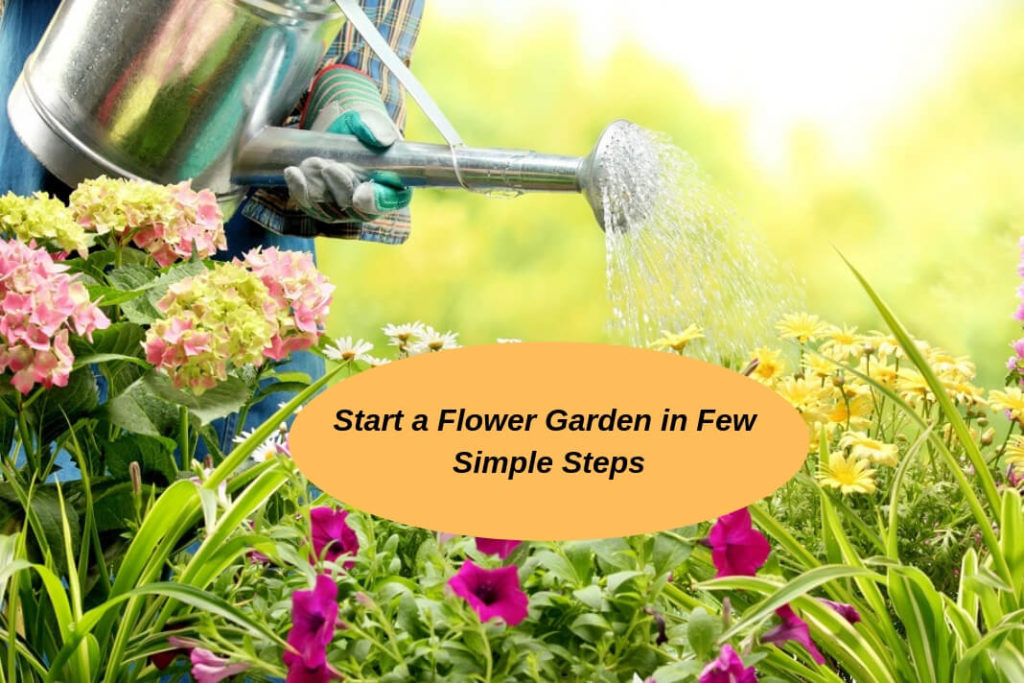
Gardening is like meditation; the planting process, the nurturing, and ultimately the bright colors of flowers relieve you from stress and rejuvenate your mind. It is one of the best side-lines you can pursue if you have space in your home or if your heart truly lies in plants, flowers, and planting. Starting a flower garden can be fun and enjoyable, rewarding and satisfying.
Space is not a concern here. In fact, you can start a flower garden with just fifty sq.ft. of the area. If you are an artist, planting and growing flowers could be one of the ways to explore and show your creative skills. It is a great mind exercise too or a summer hobby where you can involve your kids to take part in. So, get ready to note down the steps involved in starting a flower garden.
Steps to Start a Beautiful Flower Garden
Starting a flower garden needs a purpose, needs planning and requires dedicated time and effort. Don’t fret with the thought about starting everything from scratch. It is definitely not as difficult as it seems to be. You just have to plan and process the steps properly. There are different types of flower gardens and each type requires different planting technique.
Identify a Suitable Location to Grow Flower Bed
You may already have an idea where you want to grow your garden. It could be your balcony, backyard, veranda, front yard, or any place where you can add soil. However, different flowers need different amounts of light and so, you will have to consider it before you start planting. You have to stroll around your chosen location to find out which areas get 6 hours of light and which areas are shaded. Make a note of it.
Make sure your garden is in a noticeable area so that you don’t forget to look after it. You have to see it every day. It is always recommended to start your flower garden with a small patch of the flowerbed, say 5 by 5 feet. This size of the patch would easily let you grow around 20 to 30 types of plants.
Get the Ground Ready for Flower Bed
To plant flowerbeds, you need to clear the sod and pull out the first layer of the grass. Here is an easy way to remove the sod if you do not wish to spend too much time on it. Place thick layers of newspapers all over the area. On the newspaper, spread a 3 – 4-inch layer of potting soil mixed with compost. Leave the layer on the ground for 4 months. The sod will die off naturally and you don’t have to pull out the paper either. This is a lengthy process but saves your time considerably.
Remove rocks, stones, or pebbles from the soil after this. Till it to loosen the soil for planting. The soil should also be leveled for an even flowerbed.
Make the Soil Fertile
Most home garden soils are usually not fertile enough for flowering plants. You need to enrich it by digging and adding compost, peat moss, shredded leaves or old manure (at least into 15 cm). If you do not wish to dig, just cover the entire area with compost and let it stay as it is for few more months so that the soil absorbs the organic material naturally.
If you find it difficult to work with your soil because of high clay content, such as rocky or sandy area, you could raise the garden bed using toolkit meant for it. You can buy the tools from a local store.
Getting the soil ready could be done through a professional gardener if you doubt your abilities. You can seek advice for the first time, observe how it is done, and then continue doing on your own as and when you add more patches.
Start this process in early spring, so that by fall, you are ready to plant and grow the flowerbed.
Choose Your Flowers
You must have an idea about the kind of flowers you would like to see growing in your garden. However, you have to consider the shade and light factor. You have to also consider the amount of work you will have to put in for your flowers. For instance, there are annual flowers and there are perennials.
With perennials, you need to plant them once and they come back every year. They don’t produce more blooms and their blooms don’t last for long. Perennials include irises, roses, Russian sages, black-eyed Susans, daylilies, pansies etc.
On the other hand, annuals have to be planted each year. However, they produce more colorful blooms that tend to last longer. Sunflowers, marigolds, begonia, cosmos, chrysanthemum, dahlias are few popular annuals.
Buy Good Quality Seeds
Nowadays flowering seeds can be purchased and get them delivered via the internet. However, if you truly wish to grow a beautiful flower garden, we suggest that you do cover a mile and go to a well-known garden store, nursery or flower market. Get help from your gardener or someone who is an expert. Look for plants that have lots of green leaves.
Or, you could opt for good quality seeds and grow your own plant. Do not forget to buy the containers for the seeds. You need a flat cell or individual containers for the seeds so that they get individual space for the roots to grow without intertwining. If you don’t wish to buy the container, you can make do with cardboard egg carton with a hole in the bottom.
You can also buy biodegradable containers to minimize your efforts. These containers are placed directly on the patch.
Planting the Seeds
Before you place the seeds, you need to put seed- starting mixtures or potting soil in the container first. Don’t plant your seeds too early; you just need to plant it two to three weeks before the last frost. This statement changes from country to country though. Ask your local nursery or look up any agricultural forum in your city for the appropriate time.
Following the directions is must to get the right results. Few such includes:
- Plant a single seed in each container, right in the center.
- The depth should be four times more than the width of the seed.
- Smaller seeds should be closer to the container surface, while bigger seeds should be placed little deeper.
- Mark the seeds with labels.
- Keep the soil moist, but not overly watered.
- Pick a warm area to grow the seeds. Don’t keep near windowsills as the air chills at night. You can use heating pads meant for seeds instead.
- You can use a grow light for the seeds. But don’t leave them on for more than fifteen hours a day.
Getting Your Garden Ready for Flowering Plants
First goes the fertilizers into the flowering bed. Read the instruction before you add the quantity. Don’t plant the flowers during ‘typical frost’. The ‘last frost’ is the ideal time to plant the flowering plants into the soil. Dig holes big enough to set the soil and roots (gently separated). Fill in and pack the plant with more soil until it is leveled.
Make sure you leave enough space for each plant to grow and bloom. Spacing largely depends on the type of plant. You should consult the local nursery if you are doubtful.
Watering the Flowerbeds
Lack of water (moisture basically) can cause a flower garden to wilt and die or produce very fewer flowers. On the other hand, over watering can lead the plants to be infected with diseases. Each type of flowering plant thrives on the different watering process. You should know which one suits your type.
- New Plants, New Seedlings, Young Plant Transplants: Since they are more susceptible to stress, gently moist them. Water every day to moist the soil, but don’t soggy them. After the first week, water thrice a week to foster deep root growth.
- Do not Drown the Plants in Water: Place water exactly where it is needed, inside the soil or at the base of the plant. The roots need water, not the tips and plants. Wet foliage can prompt diseases.
- Mulching Correctly is Important: Mulching initiates good water absorption and keeps the plants and soil moist consistently. Mulch evenly and within 2 inches of the base of flowers and shrubs. Don’t mulch too close to the plants for it may prompt insects and pests to grow within.
- One Inch (1 “) of Water Each Week: That is all growing flower gardens need, including rains. You can observe the soil to determine how much water the plant requires. Heavier soils require just one session of watering per week, not more than an inch, while water to fast draining soil must be added twice a week, not more than ½ an inch.
- Water between 6 am and 10 am: The climate is generally cooler during this hour, which means it would reduce evaporation, improve photosynthesis, and retain water level throughout the day.
- Water More in Summer: Check the top 3 inches of the soil. If it is flaky and not moist, it needs to be watered.
That is all you need to know to start your flower garden. You will learn how to maintain and how to pluck flowers as and when you turn in to an expert. Although there is no steadfast rule in maintenance, ensure the soils are moist, well fertilized, well permed and mulched and watered with good quality water. Avoid underground water as much as possible to retain a healthy texture of plants.
If you have any questions regarding gardening, soils, or flowers, please feel free to ask your doubts in comments. We shall get back to you with the best solution at the earliest.




